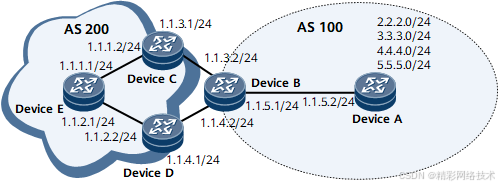学习精彩网络技术老师:华为、华三、锐捷、WLAN、IPv6等全套视频课程
网络中可根据通信需求,对接收和发布的路由通过XPL的过滤策略进行过滤。本举例用行编辑的方式对集合和过滤策略进行配置。
组网需求
如图1,运行BGP协议的网络中,DeviceA和DeviceB属于AS 100,DeviceC、DeviceD、DeviceE属于AS 200。DeviceA引入四条路由2.2.2.0/24、3.3.3.0/24、4.4.4.0/24、5.5.5.0/24。要求:
- DeviceA仅发布2.2.2.0/24、3.3.3.0/24和4.4.4.0/24路由给DeviceB;
- DeviceC接收到这三条路由后,向DeviceE发送全部路由,而DeviceD只向E发布2.2.2.0/24和3.3.3.0/24路由且需要路由2.2.2.0/24的MED值大于DeviceC发来的2.2.2.0/24,使DeviceE选择DeviceC作为发送去往2.2.2.0/24网段的流量的出口设备。
对于以上两点要求,在路由发布端配置发布策略或在路由接收端配置接收策略均能实现,在下面的举例中,将在DeviceA上配置发布策略,在DeviceE上配置接收策略来实现此功能。

| 设备名称 |
接口 |
IP地址 |
| DeviceA |
GE 0/3/0 |
1.1.5.2/24 |
| DeviceB |
GE 0/3/0 |
1.1.5.1/24 |
| DeviceB |
GE 0/3/1 |
1.1.4.2/24 |
| DeviceB |
GE 0/3/2 |
1.1.3.2/24 |
| DeviceC |
GE 0/3/1 |
1.1.1.2/24 |
| DeviceC |
GE 0/3/2 |
1.1.3.1/24 |
| DeviceD |
GE 0/3/1 |
1.1.2.2/24 |
| DeviceD |
GE 0/3/2 |
1.1.4.1/24 |
| DeviceE |
GE 0/3/1 |
1.1.2.1/24 |
| DeviceE |
GE 0/3/2 |
1.1.1.1/24 |
配置注意事项
在配置过程中,需注意以下事项:
配置思路
采用如下的思路配置对路由进行过滤:
在DeviceA、DeviceB、DeviceC、DeviceD和DeviceE上配置BGP基本功能。
在DeviceA上配置静态路由,并将这些路由引入BGP路由。
在DeviceA上配置路由发布策略,在DeviceB上查看过滤结果。
在DeviceE上配置路由接收策略,在DeviceE上查看过滤结果。
数据准备
为完成此配置例,需准备如下数据:
DeviceA引入的4条静态路由。
DeviceA、DeviceB位于AS 100,DeviceC、DeviceD和DeviceE位于AS 200。
IPv4地址前缀集合表名称,待过滤路由。
操作步骤
- 配置各接口的IP地址,请参见配置文件。
- 配置BGP协议
# DeviceA的配置。
<DeviceA> system-view
[~DeviceA] bgp 100
[*DeviceA-bgp] peer 1.1.5.1 as-number 100
[*DeviceA-bgp] commit
[~DeviceA-bgp] quit
# DeviceB的配置。
<DeviceB> system-view
[~DeviceB] bgp 100
[*DeviceB-bgp] peer 1.1.5.2 as-number 100
[*DeviceB-bgp] peer 1.1.3.1 as-number 200
[*DeviceB-bgp] peer 1.1.4.1 as-number 200
[*DeviceB-bgp] commit
[~DeviceB-bgp] quit
# DeviceC的配置。
<DeviceC> system-view
[~DeviceC] bgp 200
[*DeviceC-bgp] peer 1.1.1.1 as-number 200
[*DeviceC-bgp] peer 1.1.3.2 as-number 100
[*DeviceC-bgp] commit
[~DeviceC-bgp] quit
# DeviceD的配置。
<DeviceD> system-view
[~DeviceD] bgp 200
[*DeviceD-bgp] peer 1.1.2.1 as-number 200
[*DeviceD-bgp] peer 1.1.4.2 as-number 100
[*DeviceD-bgp] commit
[~DeviceD-bgp] quit
# DeviceE的配置。
<DeviceE> system-view
[~DeviceE] bgp 200
[*DeviceE-bgp] peer 1.1.1.2 as-number 200
[*DeviceE-bgp] peer 1.1.2.2 as-number 200</
 行编辑方式对路由接收和发布过滤示例
行编辑方式对路由接收和发布过滤示例





 最低0.47元/天 解锁文章
最低0.47元/天 解锁文章


















 1236
1236

 被折叠的 条评论
为什么被折叠?
被折叠的 条评论
为什么被折叠?










